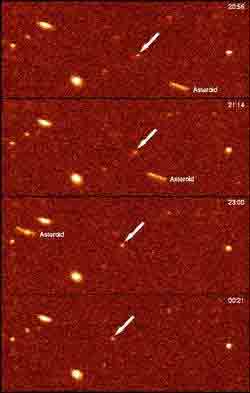|
         
> The Sun
> Mercury
> Venus
> Earth
> Mars
> Jupiter
> Saturn
> Uranus
> Neptune
> Pluto
> The 10th Planet?
> Asteroids
> Comets
> The 'Edge'
  
|
For almost as long as
history has been recorded, six planets have been known: Earth, Mars,
Venus, Mercury, Jupiter, and Saturn. This view persisted for hundreds of
years, and people thought that Saturn was the edge of the solar system.
The discovery of Uranus in modern times pushed the edge even further, and
then Neptune and Pluto expanded the width of the solar system to twice its
previously "known" size.
The discovery of Pluto prompted more speculation that there could be other
planets out there, and the existence of a "Planet X" is still passionately
believed to exist by a minority group of scientists. Some people mark the
edge with Pluto, and others still believe that the edge exists at Planet
X.
Kuiper Belt
More recent theory postulates that there exists a very
large belt of asteroids and
comets beyond Pluto that extends outwards for
several A.U., that is also s uspected
of being the source of many short period comets. Most planetary models
show that if the Kuiper belt exists, then there is no Planet X, for it
would not have been able to form, much less stay intact with all of the
debris in the Kuiper Belt. uspected
of being the source of many short period comets. Most planetary models
show that if the Kuiper belt exists, then there is no Planet X, for it
would not have been able to form, much less stay intact with all of the
debris in the Kuiper Belt.
Unfortunately for the Planet X proponents, many Kuiper belt objects (KBO's),
have been discovered in recent years. The first was found in 1992, and is
called 1992 QB1. Since then, over 500 KBO's have been found, many of them
several hundred kilometers in diameter. A table of the larger ones appears
below.
KBO's are very difficult to detect due to their vast distances from the
sun and very low surface reflectivity. Once identified, it is also very
difficult to determine anything about them, even their size. The sizes in
the table below are estimates that are based upon guesses as to how much
light they reflect.
The image to the right shows how 1992 QB1 was discovered. By photographing
the same patch of sky over the course of several hours or days, and then
looking for anything that you don't expect, you can find
asteroids, comets, or other objects. In this case, it was determined that the
unexpected object (arrows) was at a distance that would put it in the Kuiper Belt. Confirmed and extrapolated, it became the first KBO to be
discovered. [Top] Oort
Cloud
Another strong theory for defining the edge of the solar
system is the Oort Cloud, a theoretical cloud of comets that surrounds the
solar system out to a distance of two light-years (11.36 trillion miles).
The Oort Cloud was first proposed by Jan Oort in 1950. This "land of
comets" contains comet-forming nuclei left over from the formation of the
solar system. It is currently thought that this is the location where all
comets originate. The way they enter the inner solar system is by
gravitational pushes, usually by a passing star.
The Oort Cloud is believed by most scientists to exist, but it is still
only theoretical. There have been no direct sightings of any Oort Cloud
members, unlike the Kuiper Belt. [Top]
Heliopause
Most people mark the edge of the solar system where the
sun's solar wind meets that of other stars. This is a fluctuating boundary
called the heliopause. The heliopause is estimated to be approximately
17.6 billion miles away.
The two Voyager space craft should cross this within 12 years.
[Top] External Links
[Back] [Top] [Next] |
 uspected
of being the source of many short period
uspected
of being the source of many short period